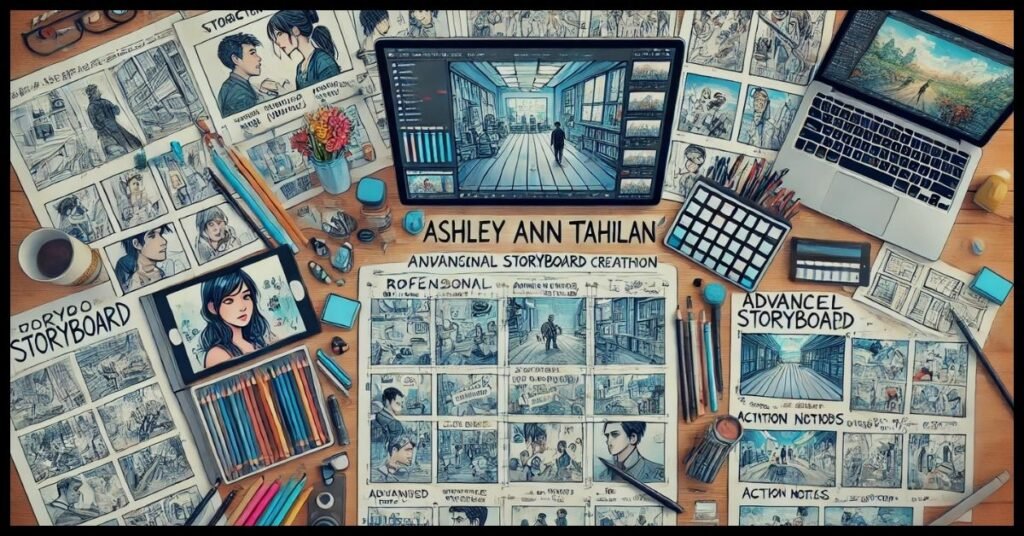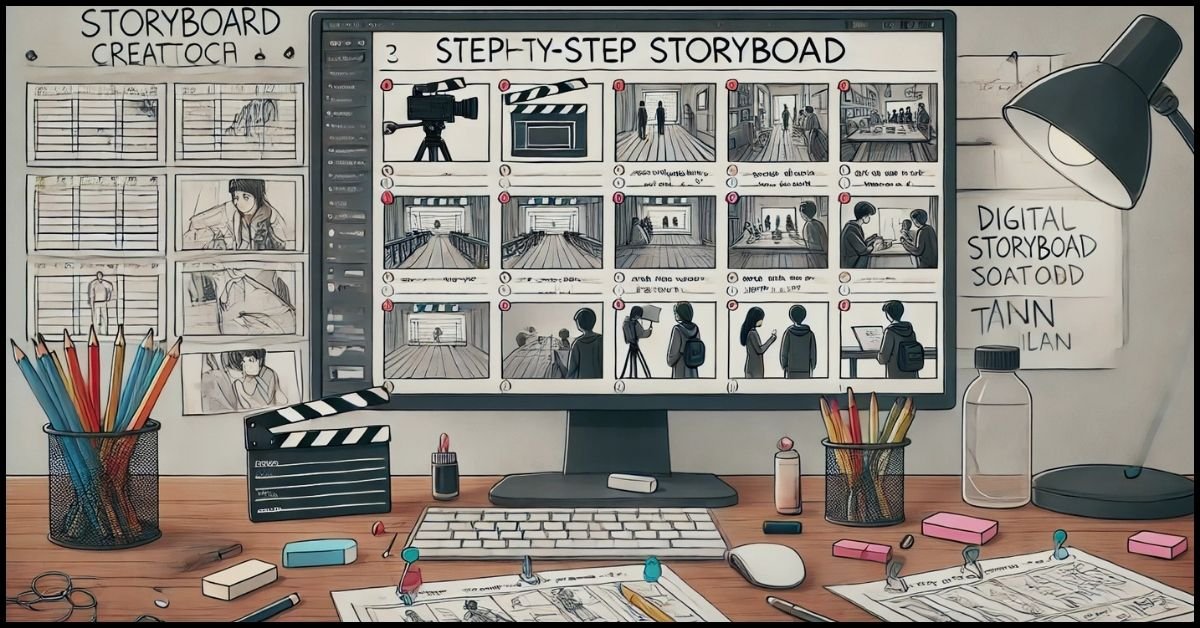Creating a storyboard is vital to any visual production, whether you’re planning a film, animation, or even a marketing campaign. One name frequently appearing in the storyboarding world is Ashley Ann Tahilan Storyboard Guide. Known for her sharp, creative approach and meticulous attention to detail, Tahilan’s work inspires many budding storyboard artists.
This guide will walk you through creating a storyboard like Ashley Ann Tahilan Storyboard Guide, breaking down each step in an easy-to-follow format. Whether you’re just starting or looking to enhance your existing skills, this guide has everything you need.
Contents
Understanding the Importance of Storyboarding

What is a Storyboard?
A storyboard is a visual representation of a script or idea. It’s made up of sequential drawings that convey the flow of a narrative or presentation. Storyboards are essential for visualizing scenes and planning shots before production begins in the film and animation industries.
Why Follow Ashley Ann Tahilan’s Approach?
Ashley Ann Tahilan is recognized for her unique ability to blend artistry with functionality in her storyboards. Her work ensures that each panel flows smoothly, making it easier for directors and animators to bring ideas to life. Following her process, you can master the balance between creativity and technical precision.
Step 1: Conceptualizing Your Story
Define Your Narrative
The first step in creating a storyboard, like Ashley Ann Tahilan does, is understanding the story you want to tell. Begin by outlining the critical elements of your narrative:
- Characters: Who are the main characters, and what are their roles?
- Setting: Where does the story take place? Is it in a fantastical world, a city, or a single room?
- Plot Points: Identify the significant moments in the story. These will serve as your storyboard’s anchor points.
Tahilan recommends being clear about your theme and tone right from the start. This helps in maintaining consistency throughout the storyboard.
Create a Script Outline
After conceptualizing the story, it’s time to write a script outline. This can be simple but should include dialogue, action, and camera movements. The script will serve as the foundation upon which the storyboard is built.
Step 2: Sketching the First Draft
Start Simple
Tahilan often starts with rough, simple sketches to block out key scenes. These don’t need to be perfect or polished; this stage focuses on composition and flow. Use stick figures, basic shapes, and arrows to indicate movement.
Here’s how you can approach the first draft:
- Divide your story into scenes: Break the narrative into manageable chunks and assign each scene to a series of storyboard panels.
- Thumbnailing: Create miniature, rough versions of each storyboard panel (thumbnails) to plan each scene visually.
- Panel Layout: Ensure each panel effectively communicates what’s happening. Use various shot types (e.g., close-ups, wide shots) to enhance visual storytelling.
Ensure Clarity and Continuity
Even in this rough stage, focus on the storyboard’s flow. Ashley Ann Tahilan emphasizes that every panel should seamlessly transition to the next. Think of how each scene connects to the one before and after, ensuring your audience can follow the story effortlessly.
Step 3: Refining Your Storyboard
Add Details to Each Panel
Now that you have a rough draft, it’s time to refine your storyboard. In this stage, you’ll add more details to each panel:
- Character Expressions and Movements: Focus on how your characters look and act in each scene. Use facial expressions, gestures, and body language to communicate emotions and actions.
- Camera Angles: Specify the camera angles you want to use for each shot. Whether it’s a bird’s-eye view or an over-the-shoulder shot, the angle plays a crucial role in how the scene is perceived.
- Backgrounds and Props: Include critical elements of the setting. While these don’t need to be highly detailed at this stage, it’s helpful to indicate major props and backgrounds to give a sense of place.
Include Dialogue and Notes
If your storyboard includes dialogue, write it beneath the panels. For actions or camera movements, use notes to explain what’s happening. These details help the team working on the project understand precisely what you envision.
Step 4: Reviewing and Revising Your Work
Collaborate and Get Feedback
One of the hallmarks of Ashley Ann Tahilan’s storyboarding process is her collaborative approach. After refining your storyboard, share it with others involved in the project—whether they’re directors, animators, or clients. Feedback is essential at this stage, as it helps identify areas for improvement and ensures everyone is aligned with the vision.
Revise for Consistency
Review the storyboard and ensure it aligns with the script and the intended mood of the project. Consistency is vital in storytelling so all elements flow smoothly from one panel to the next.
Step 5: Finalizing Your Storyboard
Polishing the Artwork
Once you’ve received feedback and made revisions, it’s time to finalize the artwork. Tahilan’s work is known for its clean lines and clear communication, so ensure your storyboard is easy to read and understand.
- Inking and Shading: Depending on the level of detail required, you should ink the lines and add shading for depth. However, keep it simple—storyboards are about conveying ideas, not creating finished artwork.
- Professional Touches: Use neat, legible fonts for dialogue and notes. Clean up any messy lines or confusing elements to ensure clarity.
Preparing for Presentation
Once your storyboard is finalized, prepare it for presentation or production. This might involve printing it out, saving it digitally, or uploading it to a project management platform. Ensure that each panel is numbered and clearly labeled so that it’s easy to follow during production.
FAQs
What software does Ashley Ann Tahilan use for storyboarding?
Ashley Ann Tahilan often uses industry-standard software such as Adobe Photoshop and Storyboard Pro, but she also emphasizes the importance of mastering hand-drawing techniques.
Can I create a storyboard without artistic skills?
Yes! You can create a functional storyboard using simple shapes and stick figures even if you’re not an artist. The key is to communicate your ideas.
How long does it take to create a storyboard?
The time varies depending on the complexity of the project. A simple storyboard might take a few hours, while a more detailed one could take days or weeks.
What are some common mistakes to avoid in storyboarding?
Common mistakes include overcrowding panels with too much detail, unclear scene transitions, and inconsistent character designs. It’s essential to focus on clarity and flow.
Why are storyboards necessary in film and animation?
Storyboards help visualize a project before it goes into production, saving time and resources by allowing the creative team to spot potential issues and make revisions early on.
Can I use a storyboard for other types of projects?
Yes! Storyboarding is not limited to film and animation. It can be used for marketing campaigns, presentations, and website design.
Conclusion
Creating a storyboard like Ashley Ann Tahilan requires a balance of creativity, technical skill, and attention to detail. By following the steps outlined in this guide, you’ll be well on your way to developing professional-quality storyboards. Whether you’re a beginner or looking to improve your skills, this step-by-step process will help you visualize your ideas effectively, ensuring your projects come to life just as you imagined.











